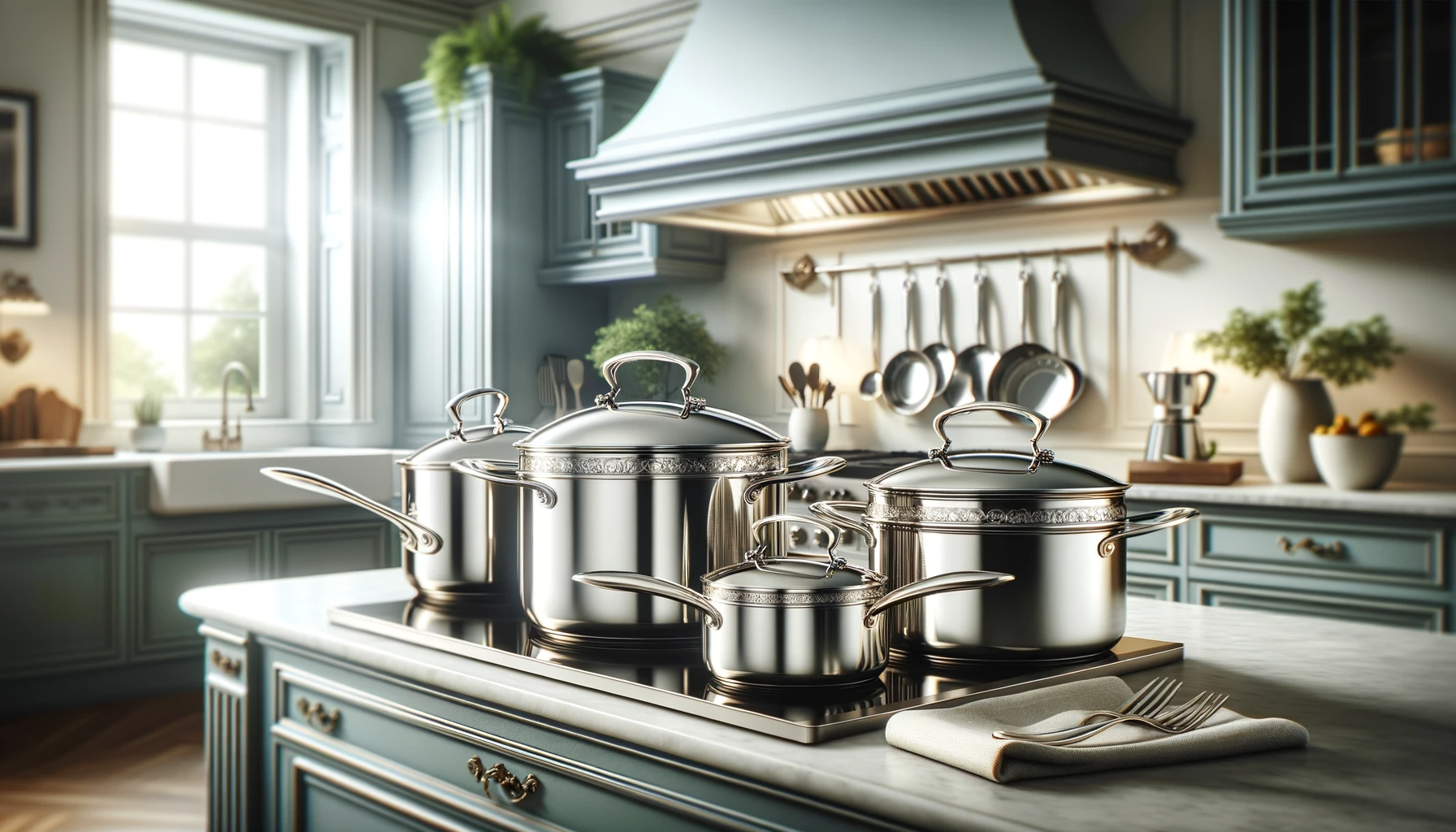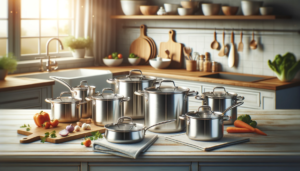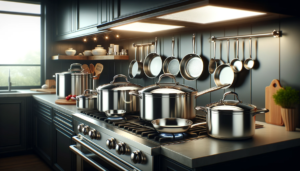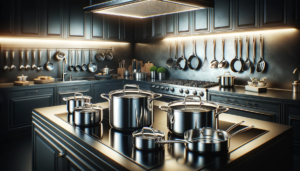Is your expensive All-Clad stainless looking a little lackluster lately? Learning proper care techniques can restore its factory finish for lifelong cooking enjoyment.
Caring for finicky stainless steel pans may seem tedious, but a little routine maintenance makes All-Clad last decades instead of a few short years.
Let’s dive into essential care for keeping stainless All-Clad cookware performing like day one for a lifetime…
How to Care for All-Clad Stainless Steel Cookware
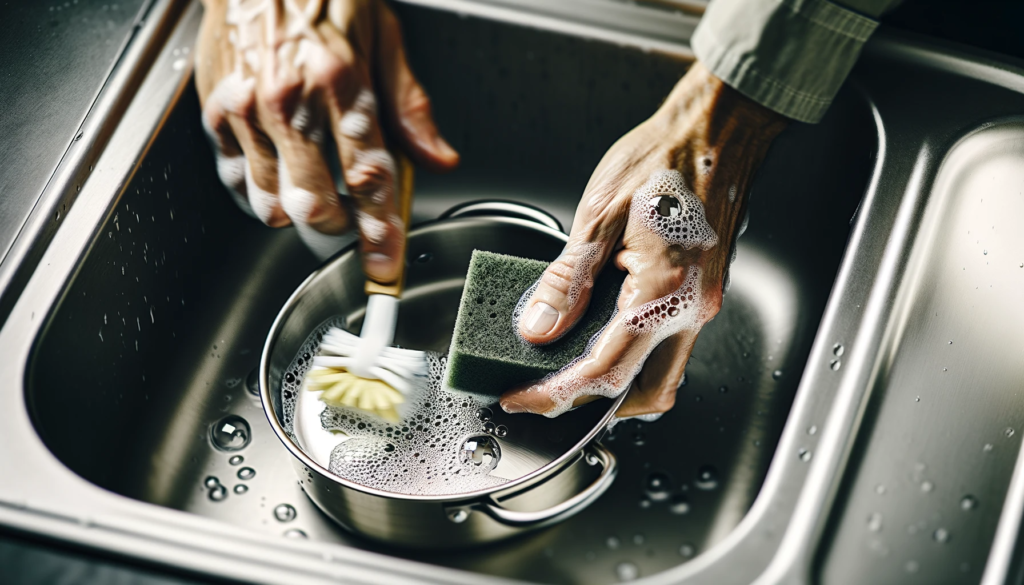
Caring for All-Clad stainless steel cookware involves regular gentle handwashing, using non-abrasive cleaners, preventing overheating damage, maintaining the finish with polish, and storing properly. Key care tips include avoiding abrasives, letting pans cool before cleaning or storage, protecting finishes from scratches and warping, and routinely applying stainless steel polish.
We’ll explore essential methods for keeping All-Clad stainless in flawless condition in greater detail ahead. But in short, gentle care practices paired with quality polish make this premium cookware last a lifetime.
Proper Cleaning Techniques
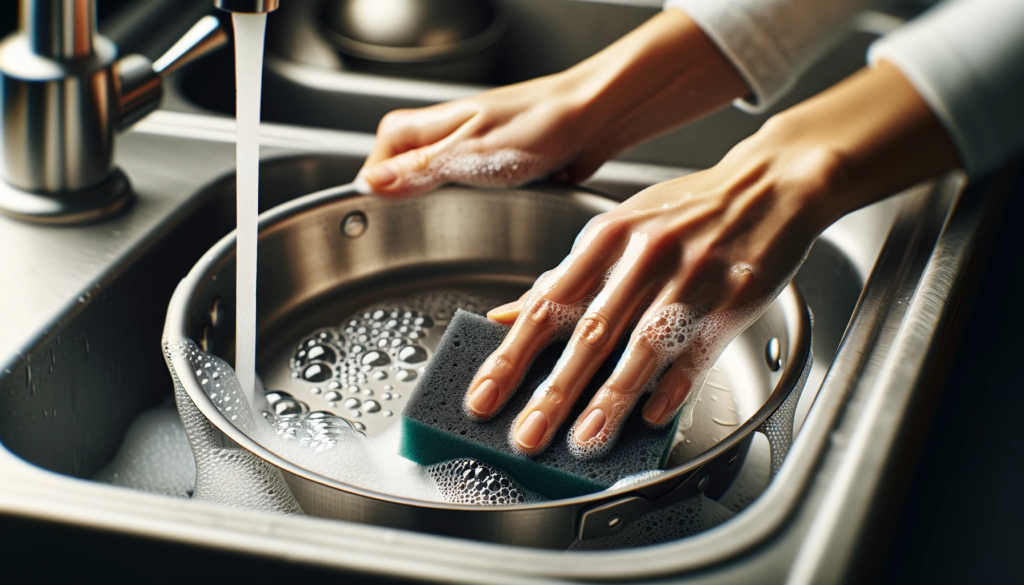
It is important to clean your All-Clad stainless steel cookware properly after each use to maintain its appearance and performance. While All-Clad pots and pans are dishwasher safe, hand washing is recommended to preserve the finish. When washing by hand, use a soft sponge or cloth with warm water and mild dish soap. The gentle friction and suds help lift grease and oils out from grooves without damaging the brushed or polished cooking surface. You will also want to avoid abrasive scrubbers like steel wool that can scratch or abrade the stainless steel surface. Occasionally some food residue may require a short soak to lift before scrubbing the surface gently. Becoming familiar with the proper cleaning techniques for your All-Clad will keep it looking like new for years.
After fully scrubbing and removing all food residues from the All-Clad, you should thoroughly rinse and then hand dry the steel surface. It is especially important not to leave soap residue, liquids or foods like saltwater sitting on the surface for extended periods, since this allows staining and corrosion of the metal to occur over time. Some additional store brand non-abrasive cleaning solutions may be safe for periodic use when needed to dissolve tougher build up or stains. However, you should always check for abrasive properties before applying any new product to such high-end stainless steel cookware. With prompt cleaning after each use using a soft sponge and dish soap, your All-Clad stainless steel can maintain its beautiful brushed finish and optimal cooking performance for many years.
Clean Immediately After Use For Best Results
For optimal results, it is best to wash your All-Clad pans immediately after cooking, while the cookware is still warm but able to be safely handled. Allowing food residue to sit for extended periods until the pan has completely cooled risks it becoming dried out and baked on, making removal much more difficult. A quick wash by hand while the pan remains somewhat elevated in temperature best preserves the stainless steel cooking surface too, lifting food particles away before they are given the chance to carbonize fully.
Of course you should avoid immediately immersing your extremely hot All-Clad pan into cold water right after cooking. The drastic temperature change is damaging for most any cookware piece. Instead, first let the pan cool down to a warm yet easily handled temperature before cleaning by hand or loading into the dishwasher. Promptly removing any cooked on foods with a combination of warm soapy water and soft scrubbing keeps your cookware looking like new after every meal.
Considerations For Hand Washing Versus Dishwasher Use
While All-Clad assures consumers its stainless steel cookware construction is technically dishwasher safe, hand washing is typically easier on any pots and pans over time. The harsh heat drying cycle, caustic chemical detergents, and high velocity spray turbulence inside a dishwasher can begin degrading metal finishes and durability sooner. For those wanting their expensive premium cookware investment to last for decades, the more gentle approach of hand washing is always most prudent. However, busy home cooks relying on modern conveniences will still use the dishwasher out of necessity.
If you do opt to place All-Clad pans in for dishwashing, be sure to use the most gentle, low temperature setting possible. Energy efficient models today often default to very high heats assuming plastic construction able to take more abuse. The stainless steel composition of All Clad makes it far more durable than typical bargain cookware. However it will still degrade faster in extreme dishwasher environments. After the cycle finishes, promptly remove All-Clad pieces to thoroughly dry and check for any stuck on food residues requiring a supplementary scrub. Consistently hand washing each piece will allow better ongoing inspection while cleaning and limit chemical exposure to preserve durability. But the convenience of the dishwasher makes it an acceptable modern shortcut.
Preventing Damage
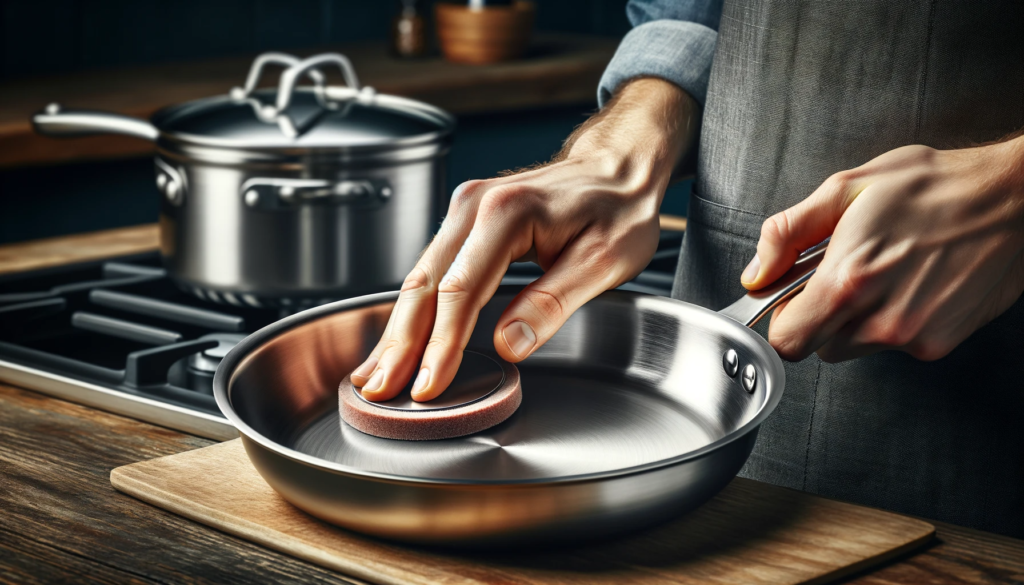
All-Clad stainless steel cookware is certainly durable compared to low cost brands, but still prone to dings, scratches, warping, or discoloration over time if mishandled or neglected consistently. Familiarizing yourself with common damage causes and taking some basic preventative measures can help properly maintain optimal functioning and lasting good appearance after years of use. For example, you should take care not to leave empty All-Clad pans sitting on a hot burner at very high temperatures for long durations unattended. Choosing appropriate burner sizes, preheating pans on lower settings, and not exceeding maximum recommended stovetop temperatures are all wise practices. Prevent dents by not aggressively nesting heavy stacked pots inside of one another for chaotic storage. More careful organization avoids the scratches and dings that come from repeatedly banging beautiful pieces together. Give some consideration too to preventing prolonged direct contact between your All-Clad and other cookware metals during storage. With a little extra care and planning during use and cleanup, your All-Clad investment can easily withstand everyday cooking demands for decades.
Don’t Overheat Empty Pans To Avoid Warping
Leaving any empty pan sitting on a hot burner to heat on maximum for an extended duration poses risks of warping and degradation over time, even thicker gauge tri-ply All-Clad construction. The austenitic 304 steel used provides excellent resistance compared to copper or aluminum pans, but no metal is truly impervious to warping under extreme repeat heat exposure when empty for long stretches. If you intend to preheat your All-Clad pans before adding oil or ingredients, use a medium or even low burner setting first for gentler acclimation. Be sure the pan size matches the burner diameter too in order to help diffuse heat effectively across all areas of the base simultaneously. Never place an empty All-Clad pan over high temperatures beyond the recommended 500 F maximum for stainless steel. While All-Clad is impressively durable, repeatedly and aggressively overheating empty pans will still create hot spots leading to warped bases and sides. Always remain attentive in the kitchen and don’t leave empty pans preheating unattended on burners capable of higher heat output than necessary. With reasonable use, your All-Clad will easily distribute heat evenly for flawless cooking performance for many years.
Exercise Care To Avoid Dents, Pits and Scratches From Impacts
As very resilient and rugged cooking equipment designed for daily use, All-Clad stainless steel cookware stands up well to moderate scratches and scuffs acquired during typical hurried kitchen use. Small surface abrasions won’t affect cooking functionality at all either. However you should still exercise some basic care when handling to avoid subjecting such beautiful pieces to unnecessary mistreatment leading to permanent damage. For example, take steps to prevent dents by avoiding the habit of haphazardly stacking excessively heavy pots nested inside of one another. Over time the extreme pressures of bearing such weight can deform pan walls or bases noticeably. Leaving ample space during storage is wise. Also refrain from angrily banging pans around on countertops and sinks, even if sometimes emotionally satisfying! The durable construction hides superficial scratches well, but repeatedly allowing large heavy pans to clash together or hit hard surfaces introduces dents and pits over time. Simply treat your high end All-Clad cookware gently as the premium kitchen investment it represents and you will be rewarded with flawless performance for decades backed by its impressive lifetime warranty.
Maintaining the Finish
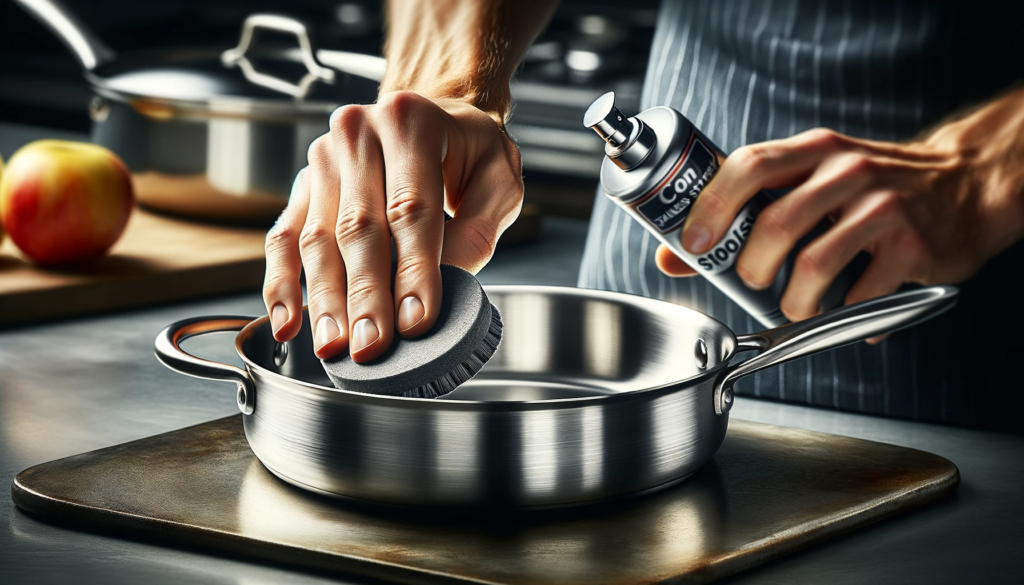
All-Clad uses high quality steel and insists on premium surface treatments, providing most pieces with either a stunning and practical high polish mirror finish or a subtler rugged brushed metal finish. Maintaining these refined appearances over decades relies on using both regular gentle cleaning methods paired then periodically with a specially formulated stainless steel polish. While structurally sound All-Clad pans themselves do not require seasoning procedures between uses like some other cooking surfaces, taking the time to gently polish by hand prevents gradual buildup of mineral deposits and water spot staining over the years of cooking. Pair occasional complete reconditioning polishes with your consistent cleaning habits after daily use, and your All-Clad stainless will maintain that freshly bought modern showroom gleam for generations of use.
Use A Polish Specific To Stainless Steel Every Few Months
All-Clad recommends using Bar Keepers Friend or a similar specially designed stainless steel cleaning polish every one to two months for optimal upkeep. The unique formulations enhance dirt and grime removal while also augmenting the protective layer to maintain the refined brushed appearance or mirror-like sheen. After you have washed pots and pans normally, apply the non-toxic polish to the still warm steel and let it set for a few brief moments before scrubbing out residues and gently buffing all surfaces out to a luminous shine. Always scrub in consistent circular motions following the original steel grain, adjusting your angle periodically rather than risk marring finishes with haphazard scrub patterns. This routine polishing keeps cooking surfaces gorgeous while also lowering adherence of grime and oils during future everyday use. If you notice isolated staining or mineral deposits between full reconditioning sessions, use a smaller amount of polish while scrubbing very gently to spot treat affected areas.
Consider Daily Cleaners From Around The Home For Upkeep Between Polishing
To simplify basic upkeep between deeper polishing treatments every few months, you can also use various kitchen pantry staple items for your regular cleaning. Common gentle ingredients like lemon juice, vinegar, baking soda and salt work very well to naturally break up and dissolve residues without damaging polished metal finishes when used properly. For example, sprinkling some salt onto particularly stubborn debris then rubbing gently with a cut lemon wedge often makes fast work of brightening cloudiness right off stainless steel. However you always want to exercise restraint and test any cleaning combinations first on inconspicuous underside or rear surfaces before applying widely across more visible areas. While convenient and effective for maintenance cleaning, even gentle everyday abrasives degrade appearance over time if used too aggressively or frequently on high quality finishes. Pair these routine cleaning strategies with All-Clad recommended polishing and your stainless steel will stay looking freshly bought out of the factory packaging for many, many years.
Storing Properly
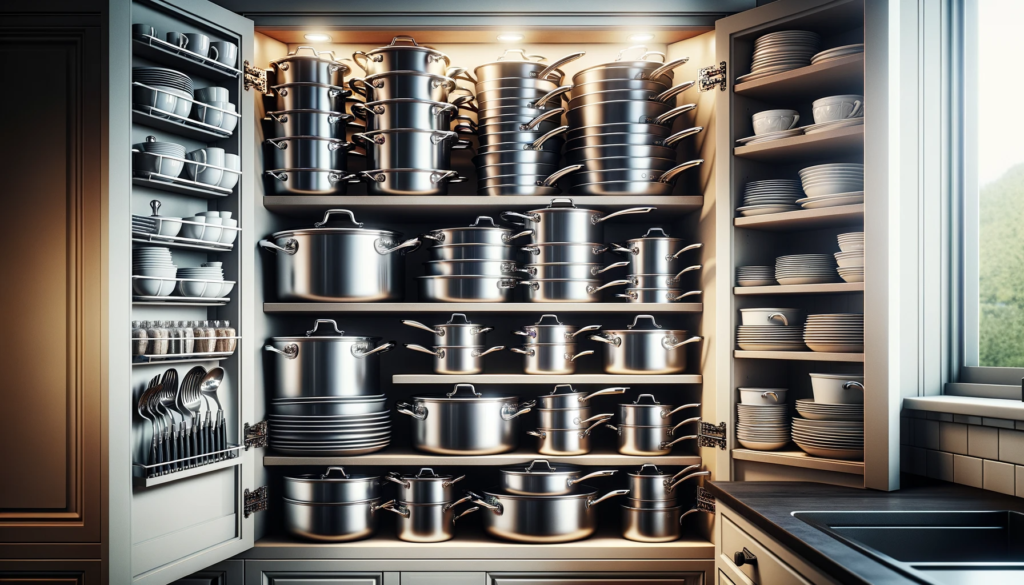
As with other elite gourmet cookware, properly storing your heavy, expensive polished All-Clad stainless steel products is equally important as cleaning for both long term performance and aesthetics. Allow ample time for pans to fully cool after use before putting away into cabinets, thoroughly clean all cooking surfaces after each meal cooked, and avoid haphazard cramped storage stacking configurations to prevent warping, dings or abrasions over years of use. Though robustly constructed of professional grade materials, consistently practicing proper storage habits prevents surface issues like pitting or texture loss as well as structural deformity. Keep your treasured All-Clad cookware investment sparkling and flawlessly functional by first letting pans fully cool before stowing after cooking, washing thoroughly before leaving soiled for long periods, and always giving your premium pieces room to breathe in cabinets rather than jamming recklessly onto shelves. The few extra minutes invested makes all the difference maintaining near factory condition for generations.
Let Cookware Cool Significantly Before Stashing Away After Cooking
After enjoying a home cooked meal via your All-Clad pan, it is crucial to allow significant cooling first before putting away cookware into kitchen cabinets for storage. While the stainless steel material conducts heat relatively poorly, the trademarked tri-ply bonded construction featuring a thick core aluminum layer means walls and bases retain residual warmth quite well after cooking ends. Dumping a still hot pan into a full sink of water for accelerated cooling risks damaging warping from sudden temperature shock over repeated occurrences. Nesting hot pans together transferred heat can also polymerize oils onto interior surfaces promotion sticky buildup you want to avoid. Instead allow pans to naturally release lingering warmth, open to air for 10-20 minutes either on the stove or countertop after cooking completes. This added mindfulness protects your major kitchen investment from unintended damage risk scenarios.
Always Clean Cookware Thoroughly Before Any Extended Storage
Never stash away All-Clad pans for hours or days without first taking a few minutes to thoroughly clean interior and exterior surfaces, even planning to fully scrub later. Food residue left sitting for hours at room temperature allows bacteria and mold colonies to take hold, as well as lets organic waste acids etch into polished cooking surfaces. Make it habit to quickly yet gently hand wash All-Clad in warm sudsy water, let air dry, and put away clean as soon as possible after every use. If needed, fill rather than submerge soiled pans to loosen stubborn baked on sauces by a short relaxation soak before tackling stuck on debris with soft abrasives. But never bed down messy cookware overnight. The quick minutes hand washing before leaving the kitchen saves great hassle down the road removing caked on messes and stains off treasured All-Clad stainless.
Preserve Flawless Appearance By Avoiding Damage During Storage
Finally, take care not to cram All-Clad pots and pans tightly stacked together on shelves during kitchen cabinet storage periods between uses. Excess weight of heavy pieces placing prolonged leverage pressure onto other pans below promotes gradual bending and loss of original shape over the years. Additionally, letting pans carelessly knock and grind together while working to slide out your desired piece adds up to fine scratches and frustrating visible dings over time. Instead allow enough spacing for ventilation to prevent residue formation as well as retaining pristine exterior conditions. For vertical hanging pot rack storage, affix protective barrier liners on shelves separating each piece to preventmetal-on-metal contact scratches. Getting in a habit of thoughtfully organizing All-Clad storage preserves function and flawless good looks for generation after generation of gourmet cooking in your family.
Conclusion
Caring for your All-Clad stainless steel cookware properly with regular cleaning, preventative measures, polishing, and mindful storage will keep it sparkling like new for decades. Implement these best practices after each use to maintain flawless performance and aesthetics for generations to come. When treated with care, your All-Clad investment will deliver delicious family meals for years beyond its lifetime warranty.
